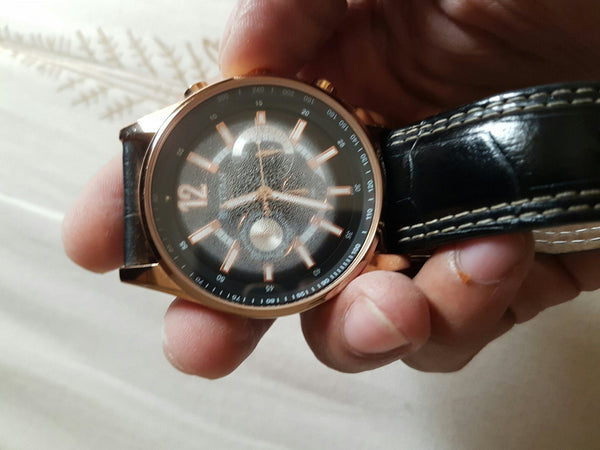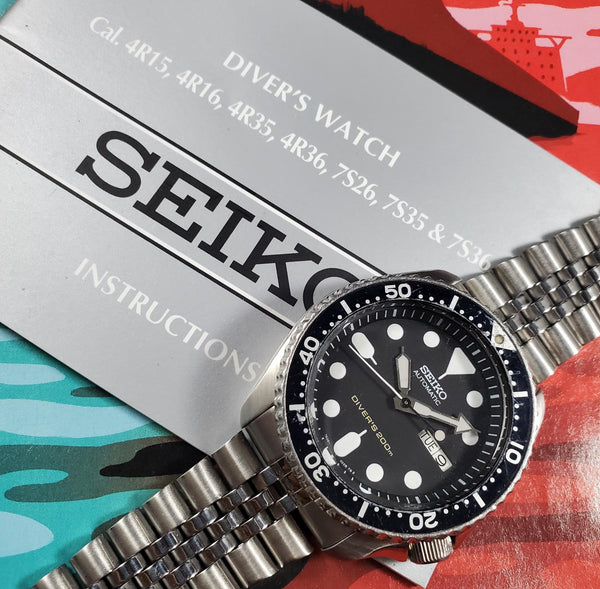How to Remove Water and Moisture from Your Seiko Watch
When you notice moisture or condensation inside your Seiko watch, you might start to worry. Of course, Seiko Diver's watches are highly water resistant, but they need regular service to maintain its quality and performance.
A little bit of moisture in a watch is a problem, but there are many simple solutions. It is common for moisture and condensation to occur inside watches, and it can happen for a number or reasons.
Humidity inside watches has been a problem for years so there are many tricks to remove internal moisture from your timepiece. In this post, we will share some ideas that will help you dry out a humid watch!
What is condensation in a watch, and why does it happen?
Moisture is easy to detect in your wristwatch because you’ll notice that the inside of the crystal would appear cloudy, foggy or you’ll see visible internal droplets. Watches with a transparent casebacks can also show visible signs of moisture in the movement, or on the caseback itself. Internal condensation, if left unattended, can cause serious damage to your watch. Once you see this, you will want to remedy as soon as you can.

Besides obscuring the time, it can also be damaging to the watch internals. Source: Quora
One important idea to understand is that watches can only be ‘water resistant’ as there is no such thing as a 'truly waterproof' watch.
Even the most extreme diver's watches are rated to a given depth, and at some point, will allow water to come in. Most non-diver's watches are only ‘water-resistant’ to shallow depths and aren't really designed to take prolonged immersion in water.
For example, a watch may have a 100m water resistance rating, but if it is a few years old, and has never been serviced, it may not even be suitable for taking a shower!
Waterproof Watches Don't Exist
Anyone who knows watches knows that no matter what design is used, no watch can be 100% waterproof. You may hear the term waterproof used by dealers, but this term isn't used by watchmakers who actually know what they are talking about.

Water resistant, but never waterproof. Source: Monochrome Watches
Some diver's watches which are rated at 300m or even 1000m of water resistance are so called ‘waterproof’ watches, as they are practically impervious to water if kept in good condition and in normal day to day usage.
That is as close as you can get to a waterproof watch.
Labels are No Guarantee!
Wristwatches can lose their water resistance capability over time. The key components to keeping the inside of a watch safe from water, namely the rubber or silicone O-rings located at the crown and caseback, can become stiff and deteriorate over time.

Gaskets may seem unimportant, but they are. Source: Omega Forums
The O-ring inevitably starts aging as soon as the unit leaves the factory. Aged O-rings shrink or harden up, allowing water to enter the unit. In some cases, they may even just outright snap. This process may take many years, but it inevitably happens.
The other typical problem with water resistant watches being compromised by water is the owner’s incorrect use.
If a timepiece has a rating of 30m or 50m water resistance, these are ‘mildly’ sealed from external humidity so swimming or being caught by rain may end up causing damage even if the movement keeps running (thanks to some level of water resistance).

More pushers, more water entry points! Source: Seiko Watches
Some diver watches from prominent brands not only have a weak point at the crown but also extra pushers to operate a chronograph. All these moving parts are simply extra case openings where water can enter despite the sealing O-rings.
When diving, users must make sure that the crown and extra push buttons are properly screwed in tight. Any adjustment of these moving parts done underwater is an invitation for water to get in. No matter if your watch has a 1000m waterproof rating, if you dive with the crown pulled out, it is like leaving the door open in a submarine while underwater. In addition, your crown can actually become defective over time, and may need to be replaced.
If you are interested in a deeper knowledge about water resistance in watches you can visit our previous post on this subject!
What causes moisture on your watch face?
There are several other reasons why you may get moisture in your watch even if you don't get your watches wet.
A typical problem is a sudden change in air temperature, like entering into a warm room after going outside on a cold day. Imagine getting a cold bottle out of the refrigerator, you’ll see how water condensates over the outer surface.

Moisture: good for drink commercials but never for watches. Source: VideoHive
It’s just physics. The same thing happens to your watch; the warmer air creates condensation droplets inside the crystal. Some manufacturers add a special seal to their timepieces to keep their units from moisture damage caused by abrupt temperature change, but many sadly don't.
Another common cause of moisture is taking hot showers with your wristwatch on. Even if your timepiece has a decent water resistance rating, hot water can also cause condensation.

Sometimes, it can get too intense for a watch. Source: Crown and Caliber
Humid environments such as rainforests or jungles, or even playing sports that make you sweat significantly, can also cause moisture inside your timepiece.
Another situation that may allow moisture to enter your watch is a crack over the crystal or a poorly sealed caseback. Small amounts of water can slowly enter into your watch manifesting as condensation on your watch’s face – which means it is time to take action.
What Water Damage can do to a Watch
Water inside a watch can damage the movement if left as-is by developing rust on the metal components of the movement. Soapy or salty sea water is even more damaging.

Wouldn't want your watch looking like this. Source: Watch Guy
The inner components of a watch, like a movement’s jewels, the hands, and other small components, are very sensitive and operate in an extremely accurate way. Internal corrosion is a killer to any mechanical machine. Once the movement gets water-damaged and prevents it from accurately telling the time, then the watch is rendered unusable.
Also, if you notice that the lume effect of the markers and hands have reduced in intensity or stopped glowing, this can be another sign of water damage.
How to Remove Condensation from your Watch
We suggest two main solutions to address a moisture issue with your timepiece. One is to try to dry it out yourself if it’s just a bit of condensation where moisture affects your timepiece for a day or two max, and when the humidity inside isn't severe.
Otherwise, if you have more than a few droplets in there, it is best to get a professional to do the job.
Assuming you can do this yourself, let's look at the most popular do-it-yourself ways to remove the condensation from a watch before it destroys the movement.
Use Heat
Place your watch in its natural position (caseback down), near a radiator, a lamp, or in a sunny spot (your watch will appreciate the tan!). Whatever heating method you choose, avoid overheating as there is also possible damage if left exposed for too long. Keep an eye on your watch!
Before you apply the heat, be sure to open the watch via the crown.
A smart trick for quick results is to place your watch on the back of a computer or laptop. The hot air expelled by the cooler fans will help remove most of the condensation inside in a short time. Another trick is using a hairdryer, but be careful as this may overheat the watch.

A few minutes beside a laptop's air vent should help with the condensation a fair bit. Source: Simply Laptop
The air trapped within your watch will get warmer, making the moisture evaporate, and hopefully it will exit via the crown tube.
Maybe it is a little obvious but we should mention it anyway. NEVER put your watch inside an oven or microwave. Both will deliver too much heat and will likely damage your watch beyond repair.
Cool Air
This may be a slower option to heating the watch, but exposing your wristwatch to a cool air fan or a windy spot in your household for a couple days will end up draining inner condensation by evaporation. Again, remember to unscrew the crown to allow the trapped humid air to pass out of the watch.
Wrap it in Desiccant
A popular way to help a watch that accidentally got soaked in water is to submerge it in a desiccant substance within a sealed jar or container. The desiccant element will absorb moisture from the piece.
Popular desiccants include uncooked dry white rice, or cat litter pebbles, or even silica gel pebbles you can purchase or find in specialty shops. However, not all of these are advisable to use on a watch.

A lot more effective than rice. Source: Healthline
We suggest not using rice or cat litter pebbles to prevent possible starch or mineral dust from entering your watch. We believe that some of these desiccant tricks can end up being more harmful than helpful, so stick to using proper silica gel in sealed packs.
Modder’s Trick
A much faster and efficient way is suggested for those modders with enough skills to remove the caseback of the watch (remember you need the appropriate tools).
For watch modders, we suggest placing the watch facing downwards without the caseback while exposed to heat or sunlight or cool air. Moisture will evaporate freely upward through the open caseback.

Quite handy knowing how to mod isn't it? Source: Artifice Horoworks
An alternative for those who know their way around watch servicing (in other words, professionals or skilled modders) is to remove the movement and dial completely, then manually wipe off the moisture with a suitable soft cloth before assembling everything back into place.
You can leave the parts in a dry place for a day or two, then put it all back together.
Take it to a Watchmaker
If there is extensive water damage to your watch, our best advice is to avoid trying to fix your watch personally and just take it to a reputable watchmaker for professional repair and servicing.
If your watch is letting moisture in, you probably need new O rings and an inspection for possible cracks or sealing flaws that allowed the leak in your wristwatch in the first place.

If you're not sure how to do it, don't force it. Source: Japan Times
We also suggest having it serviced by a watchmaker rather than a jewelry shop that offers some level of wristwatch servicing. Severe moisture damage may require the need to take apart an average of 100 watch components.
Outer and inner parts need to be dried and later lubricated individually. Many also may need to be replaced. These jobs are done in drying machines by professionals, to ensure moisture and other residues are removed. Damaged pieces may need to be replaced, and all of this should be done by a pro. If the easy fixes didn't work, don’t hesitate to get professional help and save your watch!
Wrap up
Once you fix the moisture problem in your Seiko wristwatch, it is very convenient to also further understand why or where this condensation might have come from. The more you understand your Seiko, the better you’ll be able to protect it in the future. It is suggested to have your watch tested every year if you are a scuba diver, and every two years if you don't use your watch underwater on a regular basis.
Another must is to fully understand the ‘water resistance’ rating of your watch and to read the user’s manual too. Studying the manual is necessary to avoid misuse that may lead to damages in your watch.

Yeah we know, no one really reads the manual. Source: DC Vintage Watches
If you live or work in humid conditions, you may prefer to leave your watch at home or to acquire a diver's watch. When possible, avoid hot showers with your wristwatch on since high temperature and soap both challenge your watch’s ‘water resistant’ capabilities.
If you see that your watch has a cracked crystal, have it replaced as soon as possible. At namokiMODS, we offer an extensive catalogue of Seiko Mods spare parts that will keep your Seiko watch safe from moisture or dust penetration. We recommend checking our good looking and affordable sapphire crystals for a quality upgrade or replacement in case of faulty or cracked ones on your current watch.
Worn out crowns and cracked casebacks are the other two parts that usually affect the water resistance rating of your Seiko watch. Make sure that these are sealed tight and the gaskets you are using are not stiff or damaged, otherwise your watch may not be fully protected from water leaking inside. You can follow this link to see a variety of replacement parts.
For more guides and how-to articles, check out our Seiko Modding Guide for Beginners. And if you have any questions or suggestions, feel free to leave a comment below!

Comments
Ray said:
Hi
Really good article,comprehensive and easy to understand.
Now I know why my Seiko 200meter water resistant watch has gone cloudy-keep it out of the shower and get it serviced!
Thanks
Antony Low said:
Great article guys, very well balanced! Well done!